
Potassium iodide is a chemical compound, medication, and dietary supplement. It is a medication used for treating hyperthyroidism, in radiation emergencies, and for protecting the thyroid gland when certain types of radiopharmaceuticals are used. In the third world it is also used for treating skin sporotrichosis and phycomycosis. It is a supplement used by people with low dietary intake of iodine. It is administered orally.
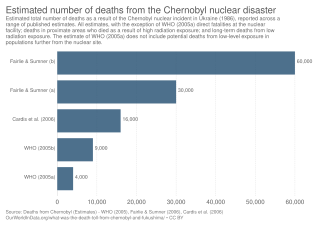
The 1986 Chernobyl disaster triggered the release of radioactive contamination into the atmosphere in the form of both particulate and gaseous radioisotopes. As of 2022, it was the world's largest known release of radioactivity into the environment.
The TORCH report was a health impacts report requested by the European Greens in 2006, for the twentieth anniversary of the Chernobyl disaster, in reply to the 2006 report of the Chernobyl Forum which was criticized by some advocacy organizations opposed to nuclear energy such as Greenpeace.
The Chernobyl Forum is the name of a group of UN agencies, founded on 3–5 February 2003 at the IAEA Headquarters in Vienna, to scientifically assess the health effects and environmental consequences of the Chernobyl accident and to issue factual, authoritative reports on its environmental and health effects.

Exposing skin to the ultraviolet radiation in sunlight has both positive and negative health effects. On the positive side, exposure allows for the synthesis of vitamin D3. Vitamin D has been suggested as having a wide range of positive health effects, which include strengthening bones and possibly inhibiting the growth of some cancers. A dietary supplement can also supply vitamin D, but there are also benefits to exposure not obtainable through Vitamin D supplementation. Long-term sun exposure is associated with reduced all-cause mortality and reduced mortality risk from cardiovascular disease (CVD), some forms of cancer, and non-CVD/noncancer related disease, with indications in these studies that Vitamin D is not the mediator. Supplementation offers limited bioavailability and no synthesis of subdermal nitric oxide. UV exposure also has positive effects for endorphin levels, and possibly for protection against multiple sclerosis. Abundant visible light to the eyes gives health benefits through its association with the timing of melatonin synthesis, maintenance of normal and robust circadian rhythms, and reduced risk of seasonal affective disorder.
Exposure to ionizing radiation is known to increase the future incidence of cancer, particularly leukemia. The mechanism by which this occurs is well understood, but quantitative models predicting the level of risk remain controversial. The most widely accepted model posits that the incidence of cancers due to ionizing radiation increases linearly with effective radiation dose at a rate of 5.5% per sievert; if correct, natural background radiation is the most hazardous source of radiation to general public health, followed by medical imaging as a close second. Additionally, the vast majority of non-invasive cancers are non-melanoma skin cancers caused by ultraviolet radiation. Non-ionizing radio frequency radiation from mobile phones, electric power transmission, and other similar sources have been investigated as a possible carcinogen by the WHO's International Agency for Research on Cancer, but to date, no evidence of this has been observed.
Linda Walsh is a British scientist who specializes in radiation epidemiology. She is an honorary visiting research fellow in the Medical Physics Department of the University of Zurich in Switzerland.
Dr. Yuri Nikiforov is an American scientist who revolutionized the understanding of thyroid cancer, most recently winning a two-year battle in which the World Health Organization has agreed in 2017 to reclassify non-invasive thyroid tumors to non-cancerogenic liaisons. Those tumors typically have some, but not all, characteristics of cancer. The WHO has agreed to change the term for the tumors from Encapsulated Follicular Variant of Papillary Thyroid Carcinoma to Noninvasive Follicular Thyroid Neoplasm With Papillary-like Nuclear Features, or NIFTP. About 45,000 people a year are diagnosed with NIFTP in the world. The decision led to a change in protocol of medical treatment, which no longer required removal of the whole thyroid gland from such patients as well as ended the use of radioactive iodine, extending their life expectancy and quality of life. The patients still undergo surgery, in which their thyroid tumors are removed, typically with half, but not all, of the thyroid gland.

Montserrat García-Closas, M.D., M.P.H., Dr.P.H., is a Spanish researcher and academic who is best known for her works on identifying cancer biomarkers and genetic susceptibility to cancer. Dr. García-Closas serves as the deputy director of the Division of Cancer Epidemiology & Genetics (DCEG) of the National Cancer Institute, as well as the Acting Chief of the Integrative Tumor Epidemiology Branch of the DCEG.

Xiaohong Rose Yang is an American biomedical scientist researching the genetics of dysplastic nevus syndrome and chordoma, and etiologic heterogeneity of breast cancer. She is a senior investigator at the National Cancer Institute. Yang leads breast cancer studies in mainland China, Hong Kong, and Malaysia.

Ruth A. Kleinerman is an American epidemiologist specialized in retinoblastoma. Kleinerman worked at the National Cancer Institute (NCI) from 1979 to 2019 where she served as a staff scientist and deputy chief of the Radiation Epidemiology Branch.

Rachael Zoe Stolzenberg-Solomon is an American epidemiologist and dietitian. She is a senior investigator and head of the metabolic epidemiology branch at the National Cancer Institute.
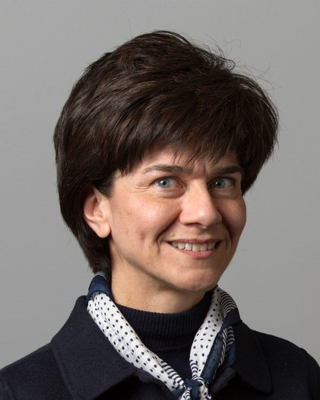
Maria Teresa Landi is an Italian epidemiologist and oncologist who researches genetic and environmental determinants of lung cancer and melanoma. At the National Cancer Institute, she is a senior investigator in the integrative tumor epidemiology branch and a senior advisor for genomic epidemiology. Landi is an associate professor of epidemiology at the Johns Hopkins Bloomberg School of Public Health.
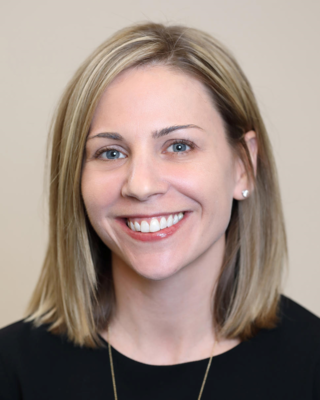
Megan A. Clarke is an American cancer epidemiologist who researches anogenital and endometrial cancers. She is a Stadtman investigator in the clinical genetics branch at the National Cancer Institute.

Shahinaz Mohamed Aly Gadalla is a physician-scientist and cancer epidemiologist who researches cancer biomarkers and hematopoietic stem cell transplantation. She is a senior investigator in the clinical genetics branch at the National Cancer Institute.
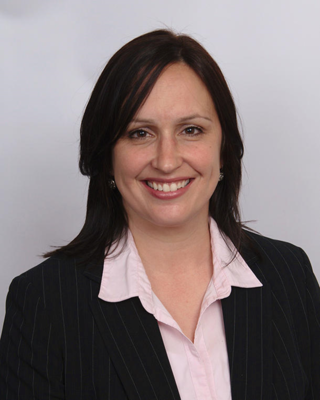
Julia C. Gage is an American cancer epidemiologist who researches cervical screening and the human papillomavirus infection. She is a staff scientist in the clinical genetics branch at the National Cancer Institute.
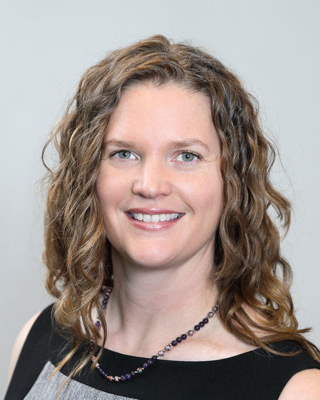
Jill E. Koshiol is an American cancer epidemiologist who researches the risk factors of hepatobiliary cancers. She is a senior investigator in the infections and immunoepidemiology branch at the National Cancer Institute.
María Constanza Camargo Bohórquez is a Colombian cancer epidemiologist who researches the Epstein–Barr virus and gastric carcinogenesis. She is an investigator in the metabolic epidemiology branch at the National Cancer Institute.
Lindsay McOmber Morton is an American cancer epidemiologist who researches genetic susceptibility to second cancers. She is the acting chief of the radiation epidemiology branch and head of its cancer survivorship research unit at the National Cancer Institute.












